Brand Management Report: Analysis of Lidl's Brand Management
VerifiedAdded on 2022/12/27
|16
|5356
|22
Report
AI Summary
This report provides an in-depth analysis of brand management, using Lidl as a case study. It begins with an introduction to brand management, its emergence, and its importance in business practices, highlighting the strategies employed to build brand recognition and equity. The report then delves into brand portfolio management, examining brand hierarchy and different models. It analyzes various techniques for leveraging and extending a brand, along with collaborative branding strategies at both domestic and global levels. The report also critically evaluates techniques for measuring and managing brand value, offering recommendations for extending, reinforcing, and revitalizing a brand. Overall, the report provides a comprehensive understanding of brand management principles and their practical application within a real-world business context.
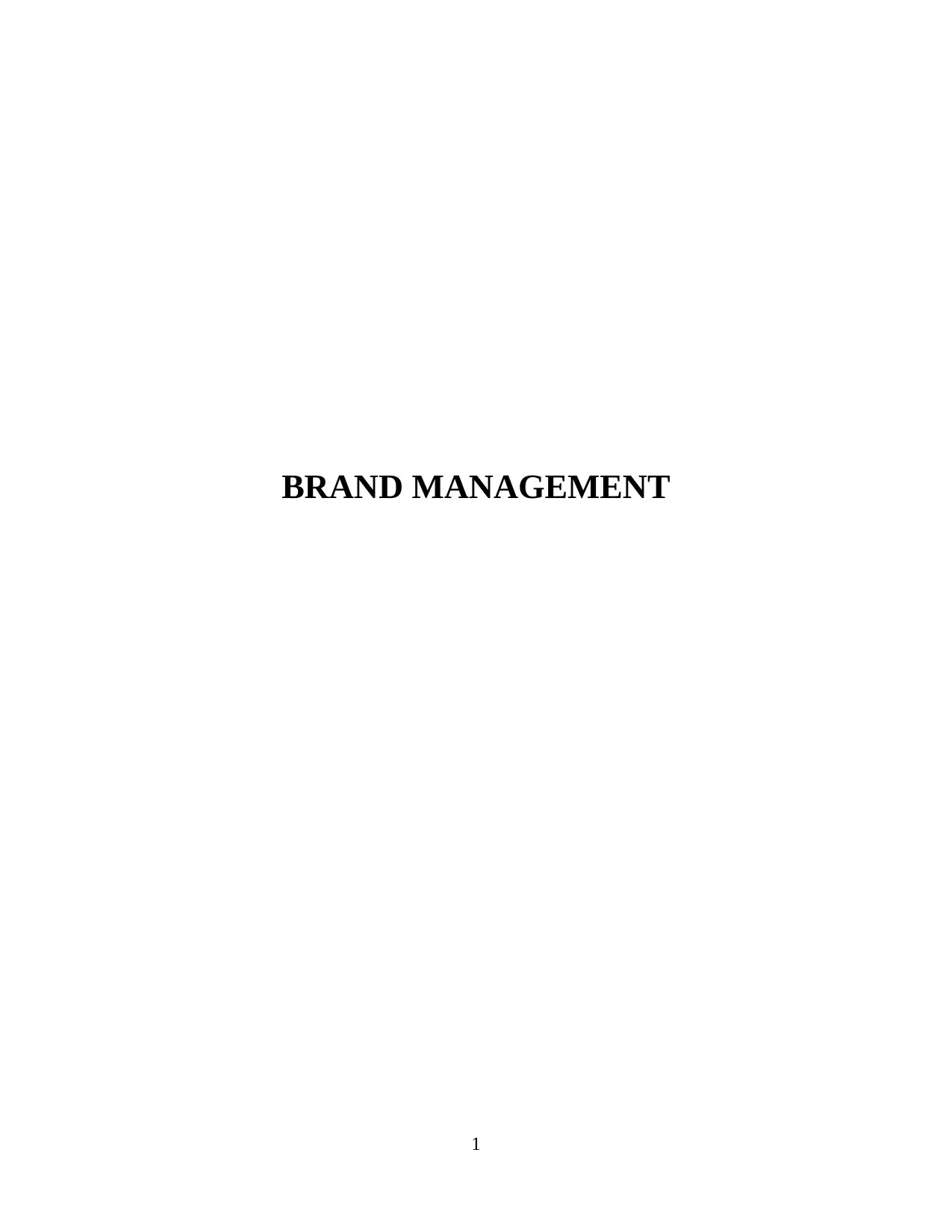
BRAND MANAGEMENT
1
1
Paraphrase This Document
Need a fresh take? Get an instant paraphrase of this document with our AI Paraphraser
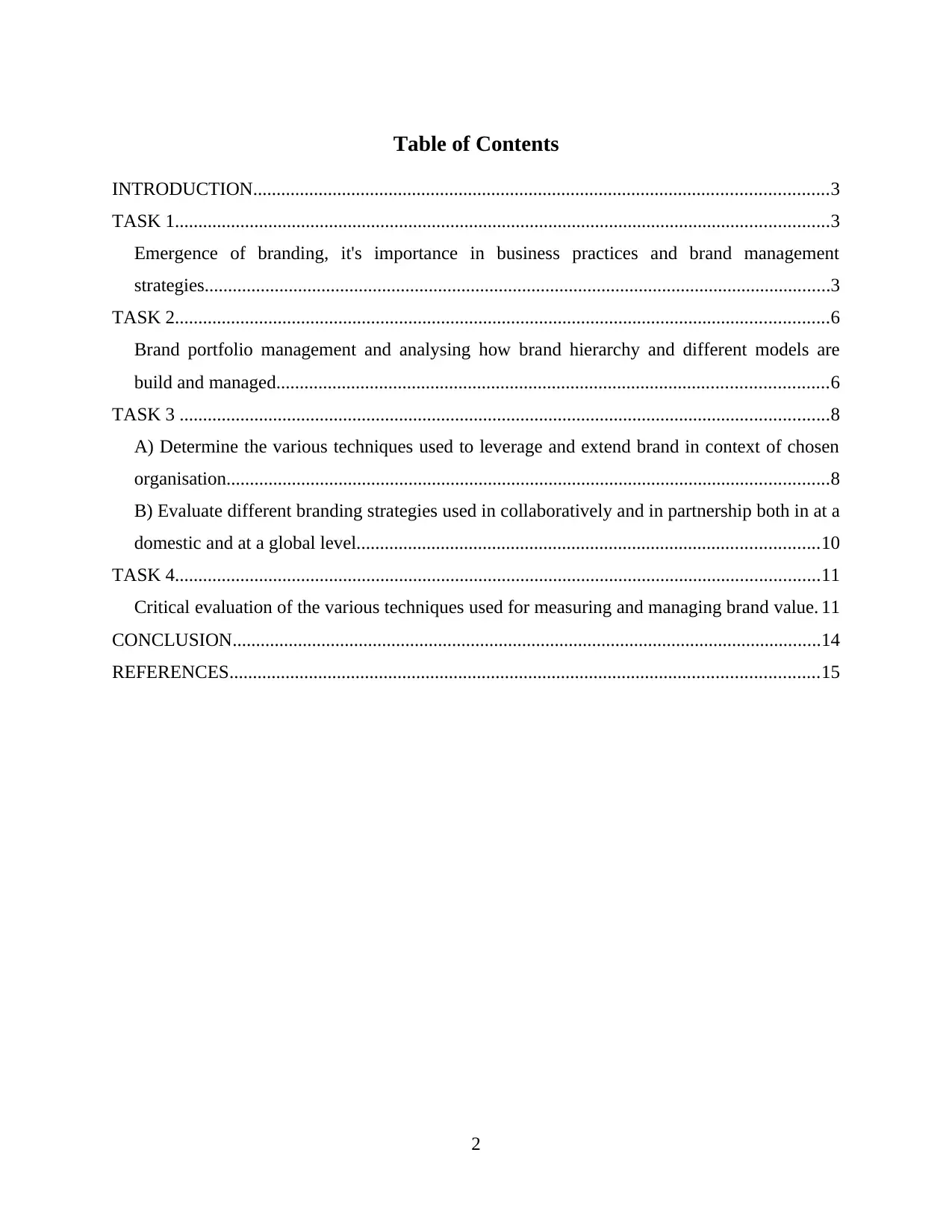
Table of Contents
INTRODUCTION...........................................................................................................................3
TASK 1............................................................................................................................................3
Emergence of branding, it's importance in business practices and brand management
strategies......................................................................................................................................3
TASK 2............................................................................................................................................6
Brand portfolio management and analysing how brand hierarchy and different models are
build and managed......................................................................................................................6
TASK 3 ...........................................................................................................................................8
A) Determine the various techniques used to leverage and extend brand in context of chosen
organisation.................................................................................................................................8
B) Evaluate different branding strategies used in collaboratively and in partnership both in at a
domestic and at a global level...................................................................................................10
TASK 4..........................................................................................................................................11
Critical evaluation of the various techniques used for measuring and managing brand value. 11
CONCLUSION..............................................................................................................................14
REFERENCES..............................................................................................................................15
2
INTRODUCTION...........................................................................................................................3
TASK 1............................................................................................................................................3
Emergence of branding, it's importance in business practices and brand management
strategies......................................................................................................................................3
TASK 2............................................................................................................................................6
Brand portfolio management and analysing how brand hierarchy and different models are
build and managed......................................................................................................................6
TASK 3 ...........................................................................................................................................8
A) Determine the various techniques used to leverage and extend brand in context of chosen
organisation.................................................................................................................................8
B) Evaluate different branding strategies used in collaboratively and in partnership both in at a
domestic and at a global level...................................................................................................10
TASK 4..........................................................................................................................................11
Critical evaluation of the various techniques used for measuring and managing brand value. 11
CONCLUSION..............................................................................................................................14
REFERENCES..............................................................................................................................15
2

INTRODUCTION
Brand management is a marketing technique through which the value of the products can
be increased (Beverland, 2021). An effective brand management strategy helps the business to
create awareness about the brand and attract loyal and potential customers. Brand management
strategies help the business to effective plan the tasks which can help them in the
accomplishment of the organisational goals. With the help of brand management strategies, the
values of the products can be increased. Lidl is a German supermarket company which have
stores all around Europe and United States. The company was established by Josef Schwarz
in1973 and the headquarters are situated in Neckarsulm, Germany. The company ensure to
deliver fresh and high quality food products. This project consists of necessary information
regarding the understanding of the brand, what techniques are used for managing the brand value
and the strategies that are adopted for management of portfolio and management of brand equity.
TASK 1
Emergence of branding, it's importance in business practices and brand management strategies
The concept of branding came in highlight in 1500's which was in the 19th and 20th
century (Borkovsky and et.al., 2017). Branding is a marketing technique which help a company
to build goodwill in the market. This technique of marketing help the business to distinguish it's
products from other brands and also to create an positive impact on the customers. The
companies can promote their brand by advertising and building reputation in the market.
Importance of Branding
Brand equity is a technique through which the social value of the brand can be measured.
Brand positioning techniques help the business to target customers and distinguish their products
and services from the competitive brands. Branding is an important factor which help the
business in creating an impact on the consumers, some of the reasons which states the
importance of the business are explained below:
Recognition: By implementing effective brand management strategies, a business can
gain recognition and the awareness about the brand can be increased in the market. The
logo of the company acts as the visual representation or face of the company which help
the customers to recognise the brand by their logo's. An effective branding strategies can
help the business in creating goodwill in the market. Lidl focuses on promoting their
3
Brand management is a marketing technique through which the value of the products can
be increased (Beverland, 2021). An effective brand management strategy helps the business to
create awareness about the brand and attract loyal and potential customers. Brand management
strategies help the business to effective plan the tasks which can help them in the
accomplishment of the organisational goals. With the help of brand management strategies, the
values of the products can be increased. Lidl is a German supermarket company which have
stores all around Europe and United States. The company was established by Josef Schwarz
in1973 and the headquarters are situated in Neckarsulm, Germany. The company ensure to
deliver fresh and high quality food products. This project consists of necessary information
regarding the understanding of the brand, what techniques are used for managing the brand value
and the strategies that are adopted for management of portfolio and management of brand equity.
TASK 1
Emergence of branding, it's importance in business practices and brand management strategies
The concept of branding came in highlight in 1500's which was in the 19th and 20th
century (Borkovsky and et.al., 2017). Branding is a marketing technique which help a company
to build goodwill in the market. This technique of marketing help the business to distinguish it's
products from other brands and also to create an positive impact on the customers. The
companies can promote their brand by advertising and building reputation in the market.
Importance of Branding
Brand equity is a technique through which the social value of the brand can be measured.
Brand positioning techniques help the business to target customers and distinguish their products
and services from the competitive brands. Branding is an important factor which help the
business in creating an impact on the consumers, some of the reasons which states the
importance of the business are explained below:
Recognition: By implementing effective brand management strategies, a business can
gain recognition and the awareness about the brand can be increased in the market. The
logo of the company acts as the visual representation or face of the company which help
the customers to recognise the brand by their logo's. An effective branding strategies can
help the business in creating goodwill in the market. Lidl focuses on promoting their
3
⊘ This is a preview!⊘
Do you want full access?
Subscribe today to unlock all pages.

Trusted by 1+ million students worldwide
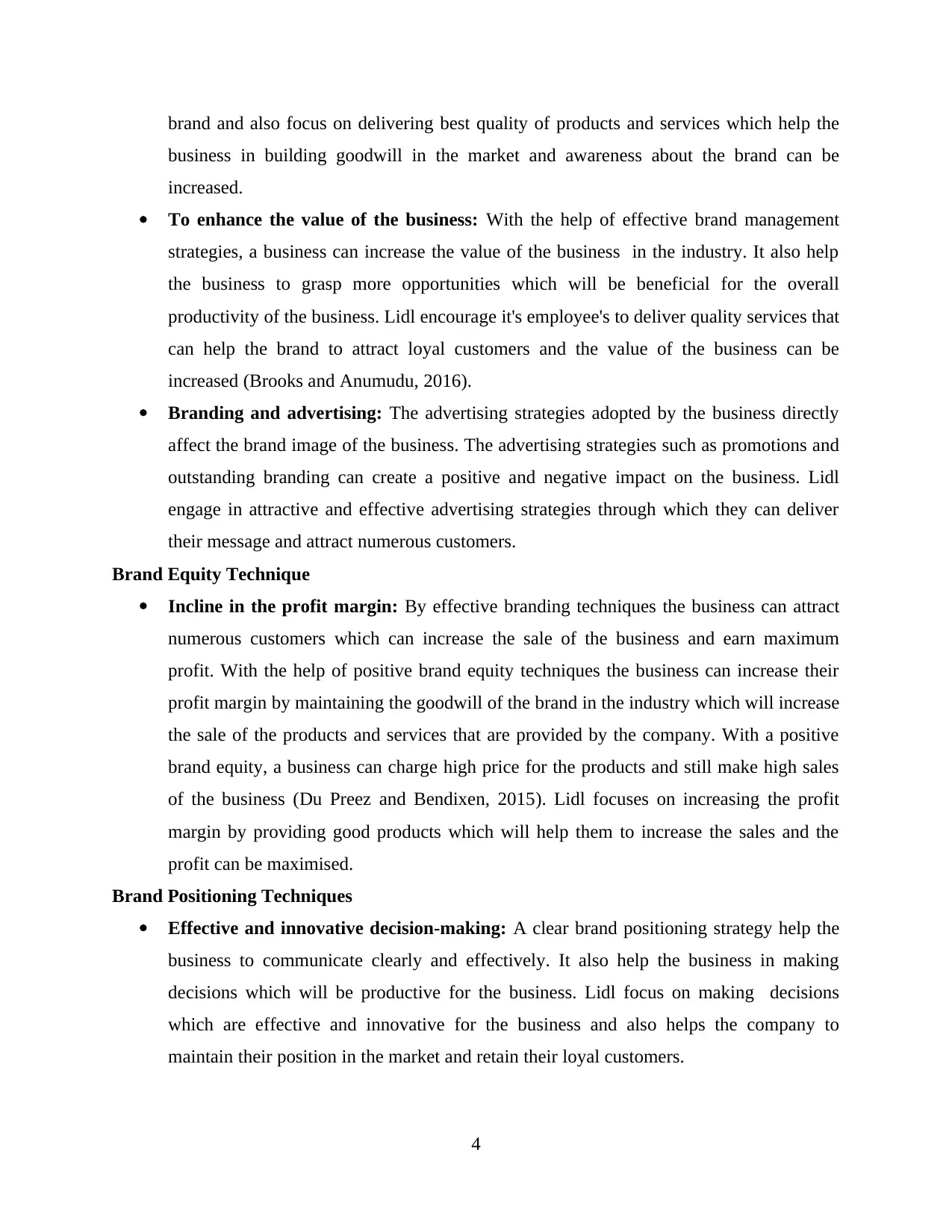
brand and also focus on delivering best quality of products and services which help the
business in building goodwill in the market and awareness about the brand can be
increased.
To enhance the value of the business: With the help of effective brand management
strategies, a business can increase the value of the business in the industry. It also help
the business to grasp more opportunities which will be beneficial for the overall
productivity of the business. Lidl encourage it's employee's to deliver quality services that
can help the brand to attract loyal customers and the value of the business can be
increased (Brooks and Anumudu, 2016).
Branding and advertising: The advertising strategies adopted by the business directly
affect the brand image of the business. The advertising strategies such as promotions and
outstanding branding can create a positive and negative impact on the business. Lidl
engage in attractive and effective advertising strategies through which they can deliver
their message and attract numerous customers.
Brand Equity Technique
Incline in the profit margin: By effective branding techniques the business can attract
numerous customers which can increase the sale of the business and earn maximum
profit. With the help of positive brand equity techniques the business can increase their
profit margin by maintaining the goodwill of the brand in the industry which will increase
the sale of the products and services that are provided by the company. With a positive
brand equity, a business can charge high price for the products and still make high sales
of the business (Du Preez and Bendixen, 2015). Lidl focuses on increasing the profit
margin by providing good products which will help them to increase the sales and the
profit can be maximised.
Brand Positioning Techniques
Effective and innovative decision-making: A clear brand positioning strategy help the
business to communicate clearly and effectively. It also help the business in making
decisions which will be productive for the business. Lidl focus on making decisions
which are effective and innovative for the business and also helps the company to
maintain their position in the market and retain their loyal customers.
4
business in building goodwill in the market and awareness about the brand can be
increased.
To enhance the value of the business: With the help of effective brand management
strategies, a business can increase the value of the business in the industry. It also help
the business to grasp more opportunities which will be beneficial for the overall
productivity of the business. Lidl encourage it's employee's to deliver quality services that
can help the brand to attract loyal customers and the value of the business can be
increased (Brooks and Anumudu, 2016).
Branding and advertising: The advertising strategies adopted by the business directly
affect the brand image of the business. The advertising strategies such as promotions and
outstanding branding can create a positive and negative impact on the business. Lidl
engage in attractive and effective advertising strategies through which they can deliver
their message and attract numerous customers.
Brand Equity Technique
Incline in the profit margin: By effective branding techniques the business can attract
numerous customers which can increase the sale of the business and earn maximum
profit. With the help of positive brand equity techniques the business can increase their
profit margin by maintaining the goodwill of the brand in the industry which will increase
the sale of the products and services that are provided by the company. With a positive
brand equity, a business can charge high price for the products and still make high sales
of the business (Du Preez and Bendixen, 2015). Lidl focuses on increasing the profit
margin by providing good products which will help them to increase the sales and the
profit can be maximised.
Brand Positioning Techniques
Effective and innovative decision-making: A clear brand positioning strategy help the
business to communicate clearly and effectively. It also help the business in making
decisions which will be productive for the business. Lidl focus on making decisions
which are effective and innovative for the business and also helps the company to
maintain their position in the market and retain their loyal customers.
4
Paraphrase This Document
Need a fresh take? Get an instant paraphrase of this document with our AI Paraphraser
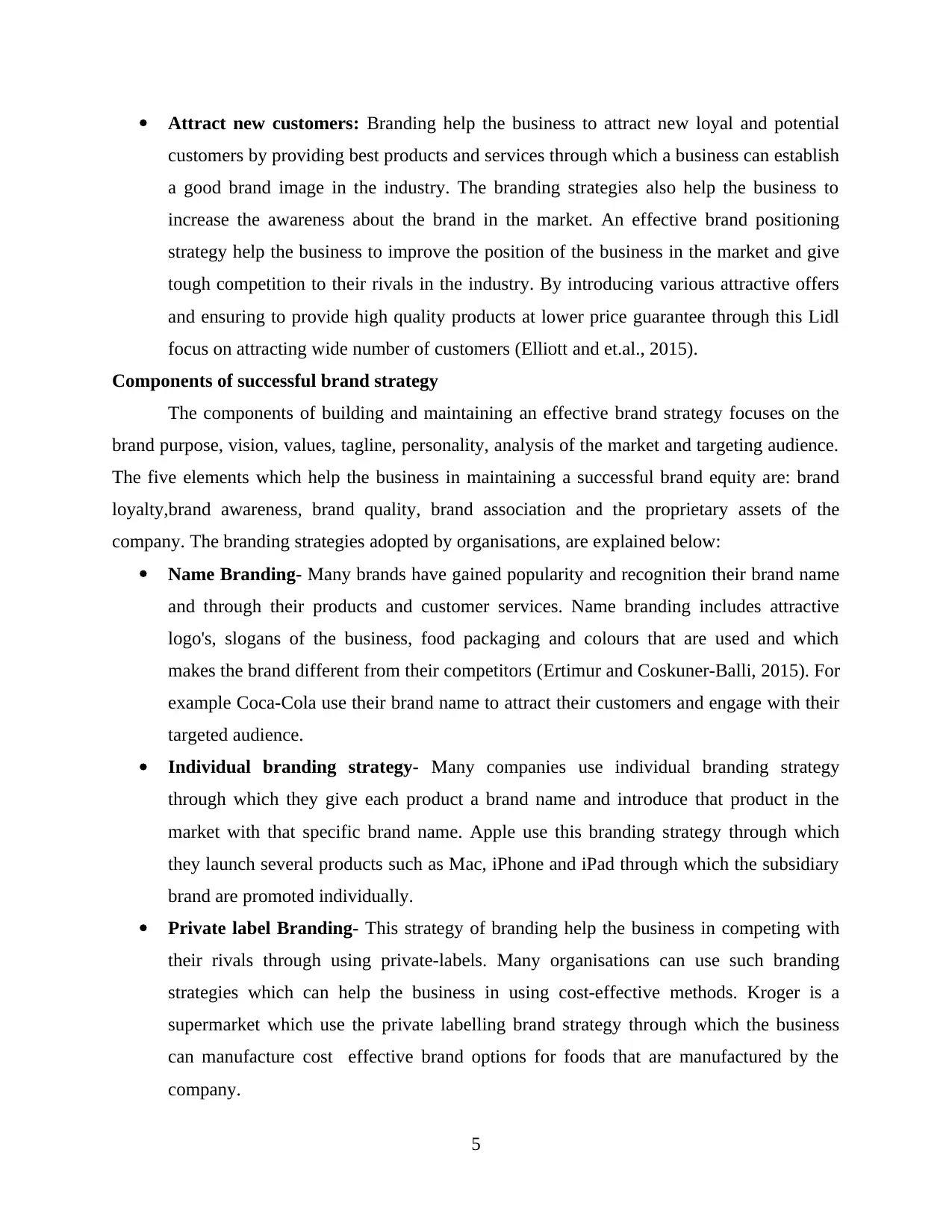
Attract new customers: Branding help the business to attract new loyal and potential
customers by providing best products and services through which a business can establish
a good brand image in the industry. The branding strategies also help the business to
increase the awareness about the brand in the market. An effective brand positioning
strategy help the business to improve the position of the business in the market and give
tough competition to their rivals in the industry. By introducing various attractive offers
and ensuring to provide high quality products at lower price guarantee through this Lidl
focus on attracting wide number of customers (Elliott and et.al., 2015).
Components of successful brand strategy
The components of building and maintaining an effective brand strategy focuses on the
brand purpose, vision, values, tagline, personality, analysis of the market and targeting audience.
The five elements which help the business in maintaining a successful brand equity are: brand
loyalty,brand awareness, brand quality, brand association and the proprietary assets of the
company. The branding strategies adopted by organisations, are explained below:
Name Branding- Many brands have gained popularity and recognition their brand name
and through their products and customer services. Name branding includes attractive
logo's, slogans of the business, food packaging and colours that are used and which
makes the brand different from their competitors (Ertimur and Coskuner-Balli, 2015). For
example Coca-Cola use their brand name to attract their customers and engage with their
targeted audience.
Individual branding strategy- Many companies use individual branding strategy
through which they give each product a brand name and introduce that product in the
market with that specific brand name. Apple use this branding strategy through which
they launch several products such as Mac, iPhone and iPad through which the subsidiary
brand are promoted individually.
Private label Branding- This strategy of branding help the business in competing with
their rivals through using private-labels. Many organisations can use such branding
strategies which can help the business in using cost-effective methods. Kroger is a
supermarket which use the private labelling brand strategy through which the business
can manufacture cost effective brand options for foods that are manufactured by the
company.
5
customers by providing best products and services through which a business can establish
a good brand image in the industry. The branding strategies also help the business to
increase the awareness about the brand in the market. An effective brand positioning
strategy help the business to improve the position of the business in the market and give
tough competition to their rivals in the industry. By introducing various attractive offers
and ensuring to provide high quality products at lower price guarantee through this Lidl
focus on attracting wide number of customers (Elliott and et.al., 2015).
Components of successful brand strategy
The components of building and maintaining an effective brand strategy focuses on the
brand purpose, vision, values, tagline, personality, analysis of the market and targeting audience.
The five elements which help the business in maintaining a successful brand equity are: brand
loyalty,brand awareness, brand quality, brand association and the proprietary assets of the
company. The branding strategies adopted by organisations, are explained below:
Name Branding- Many brands have gained popularity and recognition their brand name
and through their products and customer services. Name branding includes attractive
logo's, slogans of the business, food packaging and colours that are used and which
makes the brand different from their competitors (Ertimur and Coskuner-Balli, 2015). For
example Coca-Cola use their brand name to attract their customers and engage with their
targeted audience.
Individual branding strategy- Many companies use individual branding strategy
through which they give each product a brand name and introduce that product in the
market with that specific brand name. Apple use this branding strategy through which
they launch several products such as Mac, iPhone and iPad through which the subsidiary
brand are promoted individually.
Private label Branding- This strategy of branding help the business in competing with
their rivals through using private-labels. Many organisations can use such branding
strategies which can help the business in using cost-effective methods. Kroger is a
supermarket which use the private labelling brand strategy through which the business
can manufacture cost effective brand options for foods that are manufactured by the
company.
5
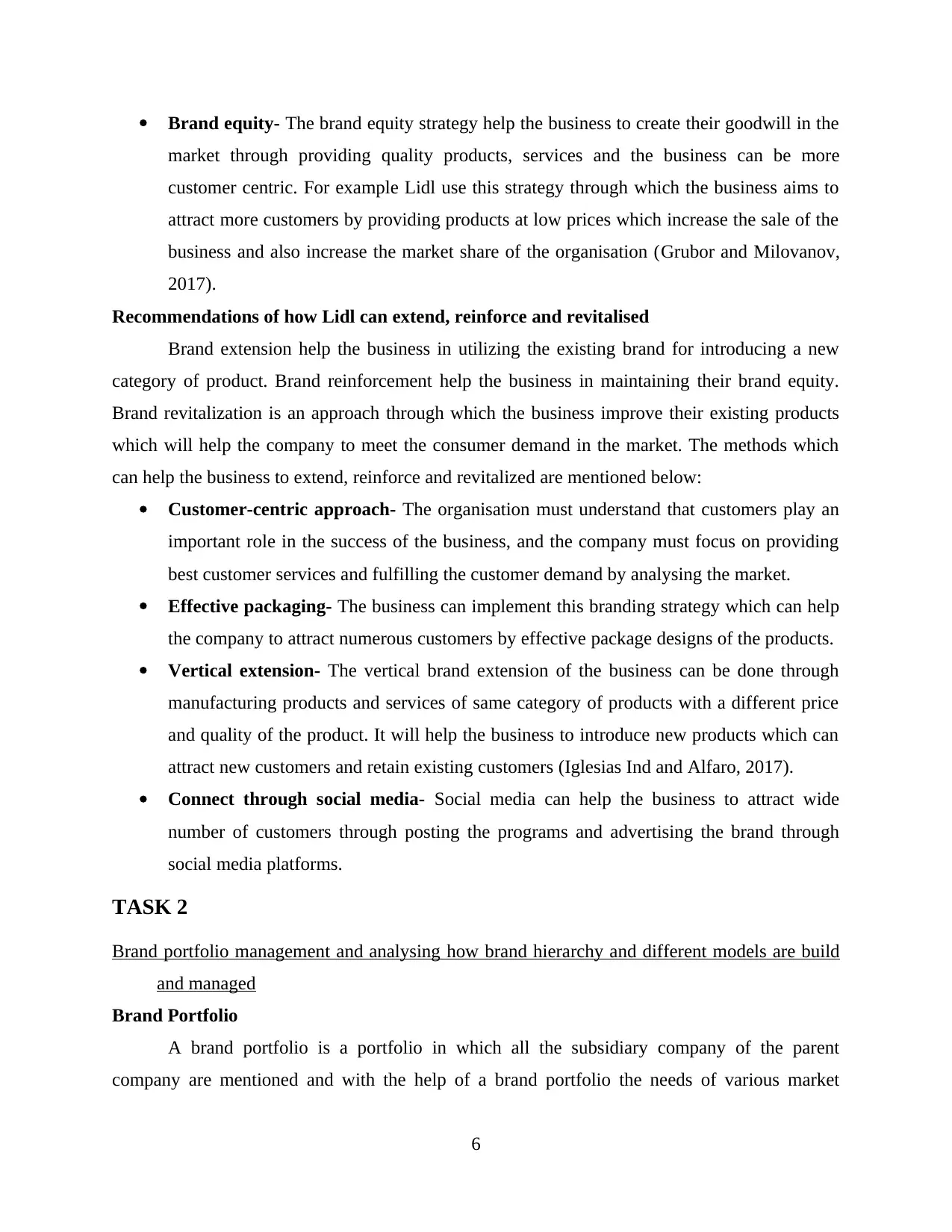
Brand equity- The brand equity strategy help the business to create their goodwill in the
market through providing quality products, services and the business can be more
customer centric. For example Lidl use this strategy through which the business aims to
attract more customers by providing products at low prices which increase the sale of the
business and also increase the market share of the organisation (Grubor and Milovanov,
2017).
Recommendations of how Lidl can extend, reinforce and revitalised
Brand extension help the business in utilizing the existing brand for introducing a new
category of product. Brand reinforcement help the business in maintaining their brand equity.
Brand revitalization is an approach through which the business improve their existing products
which will help the company to meet the consumer demand in the market. The methods which
can help the business to extend, reinforce and revitalized are mentioned below:
Customer-centric approach- The organisation must understand that customers play an
important role in the success of the business, and the company must focus on providing
best customer services and fulfilling the customer demand by analysing the market.
Effective packaging- The business can implement this branding strategy which can help
the company to attract numerous customers by effective package designs of the products.
Vertical extension- The vertical brand extension of the business can be done through
manufacturing products and services of same category of products with a different price
and quality of the product. It will help the business to introduce new products which can
attract new customers and retain existing customers (Iglesias Ind and Alfaro, 2017).
Connect through social media- Social media can help the business to attract wide
number of customers through posting the programs and advertising the brand through
social media platforms.
TASK 2
Brand portfolio management and analysing how brand hierarchy and different models are build
and managed
Brand Portfolio
A brand portfolio is a portfolio in which all the subsidiary company of the parent
company are mentioned and with the help of a brand portfolio the needs of various market
6
market through providing quality products, services and the business can be more
customer centric. For example Lidl use this strategy through which the business aims to
attract more customers by providing products at low prices which increase the sale of the
business and also increase the market share of the organisation (Grubor and Milovanov,
2017).
Recommendations of how Lidl can extend, reinforce and revitalised
Brand extension help the business in utilizing the existing brand for introducing a new
category of product. Brand reinforcement help the business in maintaining their brand equity.
Brand revitalization is an approach through which the business improve their existing products
which will help the company to meet the consumer demand in the market. The methods which
can help the business to extend, reinforce and revitalized are mentioned below:
Customer-centric approach- The organisation must understand that customers play an
important role in the success of the business, and the company must focus on providing
best customer services and fulfilling the customer demand by analysing the market.
Effective packaging- The business can implement this branding strategy which can help
the company to attract numerous customers by effective package designs of the products.
Vertical extension- The vertical brand extension of the business can be done through
manufacturing products and services of same category of products with a different price
and quality of the product. It will help the business to introduce new products which can
attract new customers and retain existing customers (Iglesias Ind and Alfaro, 2017).
Connect through social media- Social media can help the business to attract wide
number of customers through posting the programs and advertising the brand through
social media platforms.
TASK 2
Brand portfolio management and analysing how brand hierarchy and different models are build
and managed
Brand Portfolio
A brand portfolio is a portfolio in which all the subsidiary company of the parent
company are mentioned and with the help of a brand portfolio the needs of various market
6
⊘ This is a preview!⊘
Do you want full access?
Subscribe today to unlock all pages.

Trusted by 1+ million students worldwide
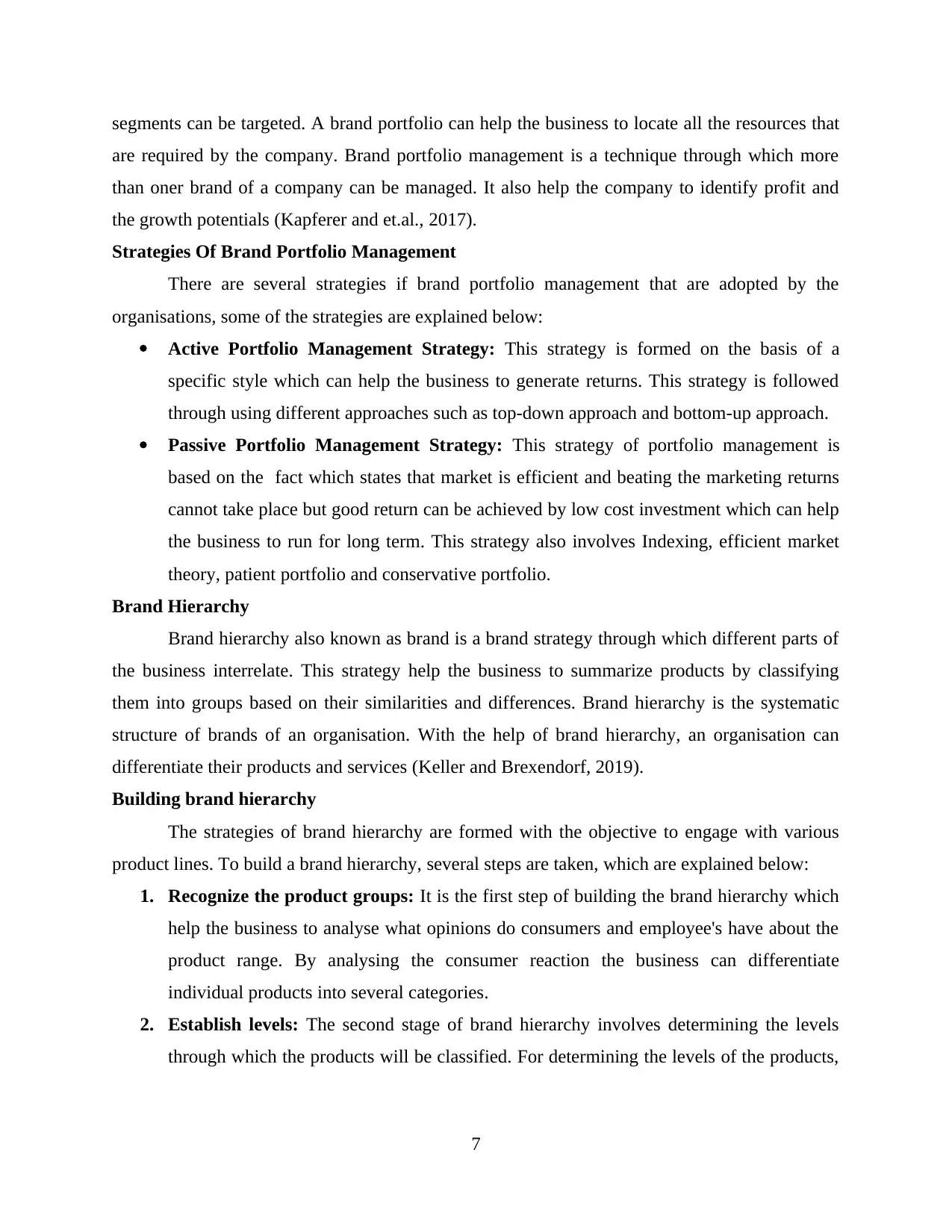
segments can be targeted. A brand portfolio can help the business to locate all the resources that
are required by the company. Brand portfolio management is a technique through which more
than oner brand of a company can be managed. It also help the company to identify profit and
the growth potentials (Kapferer and et.al., 2017).
Strategies Of Brand Portfolio Management
There are several strategies if brand portfolio management that are adopted by the
organisations, some of the strategies are explained below:
Active Portfolio Management Strategy: This strategy is formed on the basis of a
specific style which can help the business to generate returns. This strategy is followed
through using different approaches such as top-down approach and bottom-up approach.
Passive Portfolio Management Strategy: This strategy of portfolio management is
based on the fact which states that market is efficient and beating the marketing returns
cannot take place but good return can be achieved by low cost investment which can help
the business to run for long term. This strategy also involves Indexing, efficient market
theory, patient portfolio and conservative portfolio.
Brand Hierarchy
Brand hierarchy also known as brand is a brand strategy through which different parts of
the business interrelate. This strategy help the business to summarize products by classifying
them into groups based on their similarities and differences. Brand hierarchy is the systematic
structure of brands of an organisation. With the help of brand hierarchy, an organisation can
differentiate their products and services (Keller and Brexendorf, 2019).
Building brand hierarchy
The strategies of brand hierarchy are formed with the objective to engage with various
product lines. To build a brand hierarchy, several steps are taken, which are explained below:
1. Recognize the product groups: It is the first step of building the brand hierarchy which
help the business to analyse what opinions do consumers and employee's have about the
product range. By analysing the consumer reaction the business can differentiate
individual products into several categories.
2. Establish levels: The second stage of brand hierarchy involves determining the levels
through which the products will be classified. For determining the levels of the products,
7
are required by the company. Brand portfolio management is a technique through which more
than oner brand of a company can be managed. It also help the company to identify profit and
the growth potentials (Kapferer and et.al., 2017).
Strategies Of Brand Portfolio Management
There are several strategies if brand portfolio management that are adopted by the
organisations, some of the strategies are explained below:
Active Portfolio Management Strategy: This strategy is formed on the basis of a
specific style which can help the business to generate returns. This strategy is followed
through using different approaches such as top-down approach and bottom-up approach.
Passive Portfolio Management Strategy: This strategy of portfolio management is
based on the fact which states that market is efficient and beating the marketing returns
cannot take place but good return can be achieved by low cost investment which can help
the business to run for long term. This strategy also involves Indexing, efficient market
theory, patient portfolio and conservative portfolio.
Brand Hierarchy
Brand hierarchy also known as brand is a brand strategy through which different parts of
the business interrelate. This strategy help the business to summarize products by classifying
them into groups based on their similarities and differences. Brand hierarchy is the systematic
structure of brands of an organisation. With the help of brand hierarchy, an organisation can
differentiate their products and services (Keller and Brexendorf, 2019).
Building brand hierarchy
The strategies of brand hierarchy are formed with the objective to engage with various
product lines. To build a brand hierarchy, several steps are taken, which are explained below:
1. Recognize the product groups: It is the first step of building the brand hierarchy which
help the business to analyse what opinions do consumers and employee's have about the
product range. By analysing the consumer reaction the business can differentiate
individual products into several categories.
2. Establish levels: The second stage of brand hierarchy involves determining the levels
through which the products will be classified. For determining the levels of the products,
7
Paraphrase This Document
Need a fresh take? Get an instant paraphrase of this document with our AI Paraphraser

several principles must be kept in mind, which are principles of simplicity and principle
of clarity (Kelley, Sheehan and Jugenheimer, 2015).
3. Creating brands for individual levels: This is the last stage of brand hierarchy which
states that before launching an individual brand categories, the business must plan
different branding strategies for brand at all levels.
The different models of brand management are House of brands, Branded house and Hybrid.
HOUSE OF BRANDS BRANDED HOUSE HYBRID
This branding strategy are
adopted by companies through
which they introduce
individual brands and the
relevance of the parent
company may or may not be
disclosed.
Mono-brand portfolio or
branded house is the strategy
through which the company
use their corporate names on
their products for branding.
Hybrid branding strategy is an
ad-hoc strategy through which
a business can gain maximum
branding advantage through
endorsement or independence.
TASK 3
A) Determine the various techniques used to leverage and extend brand in context of chosen
organisation.
According to the changing external environment an organisation implement various
techniques to adapt according to market trend and demand. Improving product quality and range
will render market stability and growth. Brand extension, Line extension and Vertical extensions
are certain techniques used by organisation in order to implement new product quality and
improvement, to achieve product diversification in order to retain consumer satisfaction.
Developing new product range and variant will attract more customer to buy the new products as
per current market requirement (King, 2017). The different techniques used by Lidl for product
improvement are discussed below:
Brand extension
When an organisation enters into new product or strategy without changing the brand
name is called brand extension. This technique is used by the organisation to launch new product
in the existing brand name which will help to retain consumer loyalty. Whereas the organisation
looks at introducing new product features and quality for achieve consumer satisfaction and
8
of clarity (Kelley, Sheehan and Jugenheimer, 2015).
3. Creating brands for individual levels: This is the last stage of brand hierarchy which
states that before launching an individual brand categories, the business must plan
different branding strategies for brand at all levels.
The different models of brand management are House of brands, Branded house and Hybrid.
HOUSE OF BRANDS BRANDED HOUSE HYBRID
This branding strategy are
adopted by companies through
which they introduce
individual brands and the
relevance of the parent
company may or may not be
disclosed.
Mono-brand portfolio or
branded house is the strategy
through which the company
use their corporate names on
their products for branding.
Hybrid branding strategy is an
ad-hoc strategy through which
a business can gain maximum
branding advantage through
endorsement or independence.
TASK 3
A) Determine the various techniques used to leverage and extend brand in context of chosen
organisation.
According to the changing external environment an organisation implement various
techniques to adapt according to market trend and demand. Improving product quality and range
will render market stability and growth. Brand extension, Line extension and Vertical extensions
are certain techniques used by organisation in order to implement new product quality and
improvement, to achieve product diversification in order to retain consumer satisfaction.
Developing new product range and variant will attract more customer to buy the new products as
per current market requirement (King, 2017). The different techniques used by Lidl for product
improvement are discussed below:
Brand extension
When an organisation enters into new product or strategy without changing the brand
name is called brand extension. This technique is used by the organisation to launch new product
in the existing brand name which will help to retain consumer loyalty. Whereas the organisation
looks at introducing new product features and quality for achieve consumer satisfaction and
8
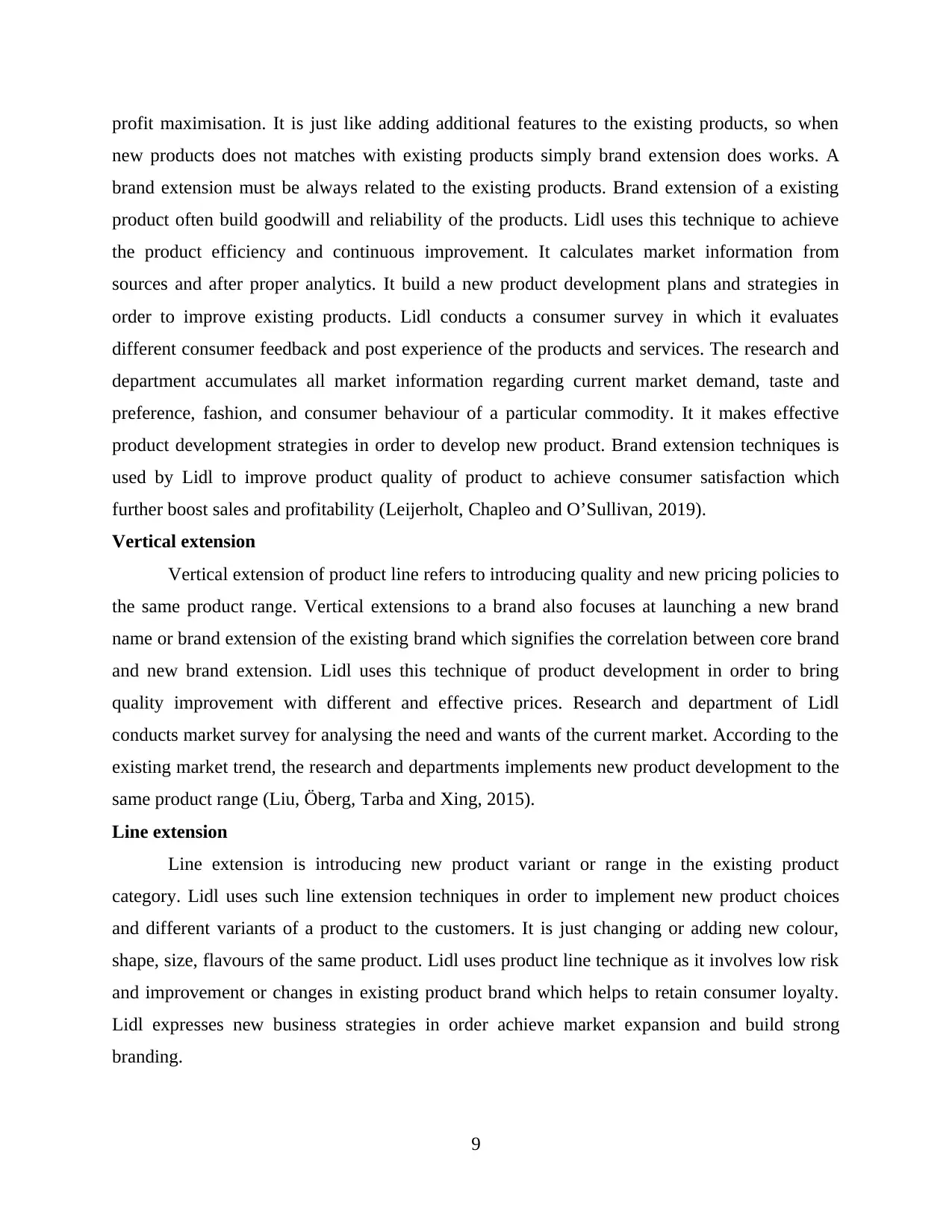
profit maximisation. It is just like adding additional features to the existing products, so when
new products does not matches with existing products simply brand extension does works. A
brand extension must be always related to the existing products. Brand extension of a existing
product often build goodwill and reliability of the products. Lidl uses this technique to achieve
the product efficiency and continuous improvement. It calculates market information from
sources and after proper analytics. It build a new product development plans and strategies in
order to improve existing products. Lidl conducts a consumer survey in which it evaluates
different consumer feedback and post experience of the products and services. The research and
department accumulates all market information regarding current market demand, taste and
preference, fashion, and consumer behaviour of a particular commodity. It it makes effective
product development strategies in order to develop new product. Brand extension techniques is
used by Lidl to improve product quality of product to achieve consumer satisfaction which
further boost sales and profitability (Leijerholt, Chapleo and O’Sullivan, 2019).
Vertical extension
Vertical extension of product line refers to introducing quality and new pricing policies to
the same product range. Vertical extensions to a brand also focuses at launching a new brand
name or brand extension of the existing brand which signifies the correlation between core brand
and new brand extension. Lidl uses this technique of product development in order to bring
quality improvement with different and effective prices. Research and department of Lidl
conducts market survey for analysing the need and wants of the current market. According to the
existing market trend, the research and departments implements new product development to the
same product range (Liu, Öberg, Tarba and Xing, 2015).
Line extension
Line extension is introducing new product variant or range in the existing product
category. Lidl uses such line extension techniques in order to implement new product choices
and different variants of a product to the customers. It is just changing or adding new colour,
shape, size, flavours of the same product. Lidl uses product line technique as it involves low risk
and improvement or changes in existing product brand which helps to retain consumer loyalty.
Lidl expresses new business strategies in order achieve market expansion and build strong
branding.
9
new products does not matches with existing products simply brand extension does works. A
brand extension must be always related to the existing products. Brand extension of a existing
product often build goodwill and reliability of the products. Lidl uses this technique to achieve
the product efficiency and continuous improvement. It calculates market information from
sources and after proper analytics. It build a new product development plans and strategies in
order to improve existing products. Lidl conducts a consumer survey in which it evaluates
different consumer feedback and post experience of the products and services. The research and
department accumulates all market information regarding current market demand, taste and
preference, fashion, and consumer behaviour of a particular commodity. It it makes effective
product development strategies in order to develop new product. Brand extension techniques is
used by Lidl to improve product quality of product to achieve consumer satisfaction which
further boost sales and profitability (Leijerholt, Chapleo and O’Sullivan, 2019).
Vertical extension
Vertical extension of product line refers to introducing quality and new pricing policies to
the same product range. Vertical extensions to a brand also focuses at launching a new brand
name or brand extension of the existing brand which signifies the correlation between core brand
and new brand extension. Lidl uses this technique of product development in order to bring
quality improvement with different and effective prices. Research and department of Lidl
conducts market survey for analysing the need and wants of the current market. According to the
existing market trend, the research and departments implements new product development to the
same product range (Liu, Öberg, Tarba and Xing, 2015).
Line extension
Line extension is introducing new product variant or range in the existing product
category. Lidl uses such line extension techniques in order to implement new product choices
and different variants of a product to the customers. It is just changing or adding new colour,
shape, size, flavours of the same product. Lidl uses product line technique as it involves low risk
and improvement or changes in existing product brand which helps to retain consumer loyalty.
Lidl expresses new business strategies in order achieve market expansion and build strong
branding.
9
⊘ This is a preview!⊘
Do you want full access?
Subscribe today to unlock all pages.

Trusted by 1+ million students worldwide

B) Evaluate different branding strategies used in collaboratively and in partnership both in at a
domestic and at a global level.
Different types of brand value techniques at domestic level:
In order to evaluate different techniques to measure brand value at domestic level includes:
comparable approach:
This method is used by Lidl in order to evaluate market brand value by comparing similar
products of other brands, involves comparison between different brands of the similar industry, it
gives an overview of positioning of the brand in the market, also states the competitors position
of the similar product in the market, by this the organisation can evaluate the brand value and the
position of the products and services in the market.
For evaluating the branding value in UK, Lidl uses different analytical approach like cost based
method which refers accumulation of the cost incurred in comparison with market value of the
product (Majerova and et.al., 2020).
Lidl also uses different trend analysis which involves legal, financial and behavioural
analysis. Financial analysis involves calculation of cost, and economic approach to evaluate the
brand value. It involves gathering statistical and analytical data. Whereas, behavioural analysis
involves conducting market survey and feedback from customers and stakeholder to determine
value of the brand in market.
The different techniques to evaluate the brand value at global level are discussed below:
Assessing Attributes
It involves determining different attributes like market share, market growth and
customer satisfaction of product and services in the market. Lidl assess these attributes in order
to evaluate the brand value at global level. Lidl is already a leading international brand, it
conducts different statistical approaches to evaluate market share and growth. Consumer surveys
are been conducted for taking each consumer feedback regarding product (Moretta Tartaglione
and et.al., 2019).
Brand equity
these involves calculation sales, number of customer using the product continuously.
brand equity states consumer perception and positioning of brand in the market. It is defined as
how a consumer perceives about a brand. Lidl prepares strategic plans and policies to cope up
10
domestic and at a global level.
Different types of brand value techniques at domestic level:
In order to evaluate different techniques to measure brand value at domestic level includes:
comparable approach:
This method is used by Lidl in order to evaluate market brand value by comparing similar
products of other brands, involves comparison between different brands of the similar industry, it
gives an overview of positioning of the brand in the market, also states the competitors position
of the similar product in the market, by this the organisation can evaluate the brand value and the
position of the products and services in the market.
For evaluating the branding value in UK, Lidl uses different analytical approach like cost based
method which refers accumulation of the cost incurred in comparison with market value of the
product (Majerova and et.al., 2020).
Lidl also uses different trend analysis which involves legal, financial and behavioural
analysis. Financial analysis involves calculation of cost, and economic approach to evaluate the
brand value. It involves gathering statistical and analytical data. Whereas, behavioural analysis
involves conducting market survey and feedback from customers and stakeholder to determine
value of the brand in market.
The different techniques to evaluate the brand value at global level are discussed below:
Assessing Attributes
It involves determining different attributes like market share, market growth and
customer satisfaction of product and services in the market. Lidl assess these attributes in order
to evaluate the brand value at global level. Lidl is already a leading international brand, it
conducts different statistical approaches to evaluate market share and growth. Consumer surveys
are been conducted for taking each consumer feedback regarding product (Moretta Tartaglione
and et.al., 2019).
Brand equity
these involves calculation sales, number of customer using the product continuously.
brand equity states consumer perception and positioning of brand in the market. It is defined as
how a consumer perceives about a brand. Lidl prepares strategic plans and policies to cope up
10
Paraphrase This Document
Need a fresh take? Get an instant paraphrase of this document with our AI Paraphraser
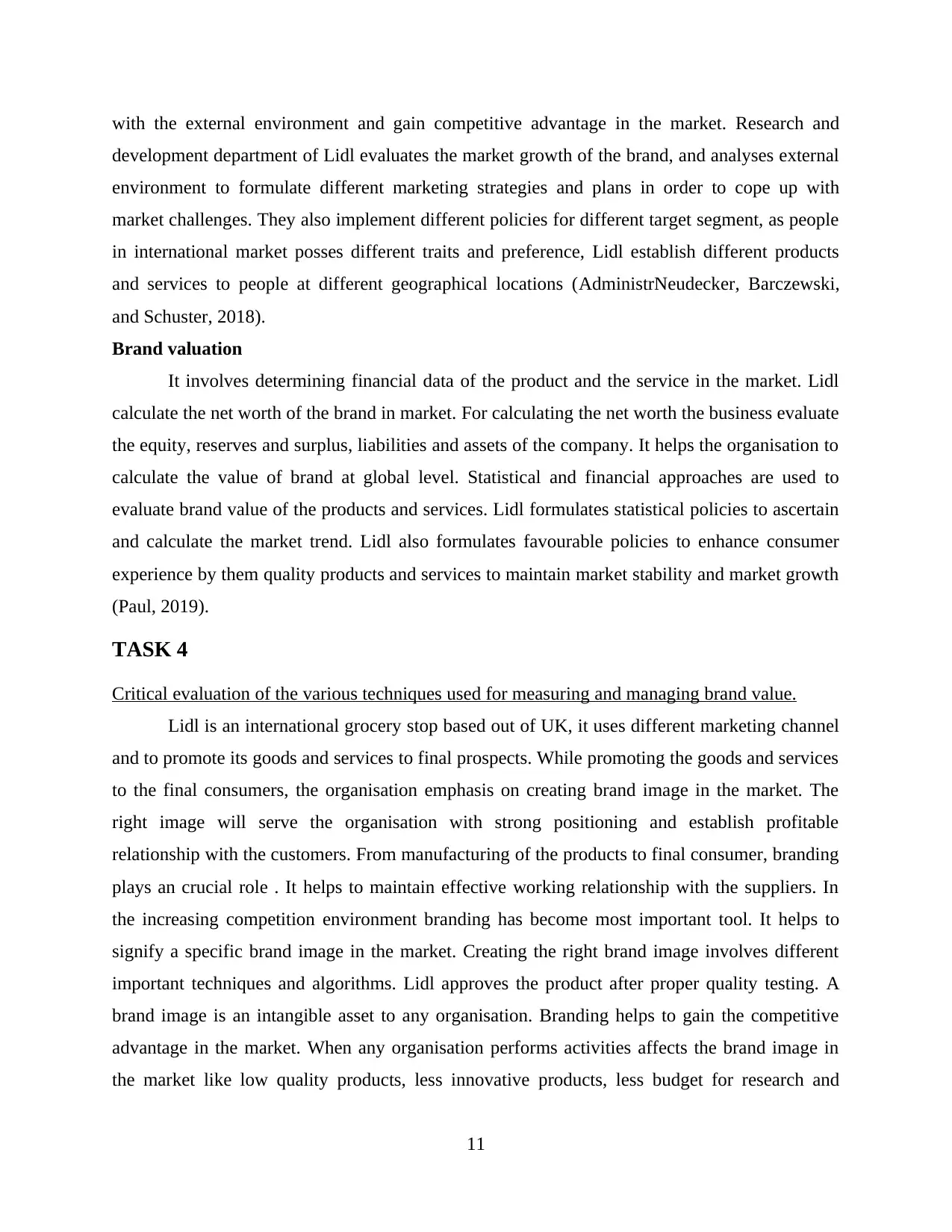
with the external environment and gain competitive advantage in the market. Research and
development department of Lidl evaluates the market growth of the brand, and analyses external
environment to formulate different marketing strategies and plans in order to cope up with
market challenges. They also implement different policies for different target segment, as people
in international market posses different traits and preference, Lidl establish different products
and services to people at different geographical locations (AdministrNeudecker, Barczewski,
and Schuster, 2018).
Brand valuation
It involves determining financial data of the product and the service in the market. Lidl
calculate the net worth of the brand in market. For calculating the net worth the business evaluate
the equity, reserves and surplus, liabilities and assets of the company. It helps the organisation to
calculate the value of brand at global level. Statistical and financial approaches are used to
evaluate brand value of the products and services. Lidl formulates statistical policies to ascertain
and calculate the market trend. Lidl also formulates favourable policies to enhance consumer
experience by them quality products and services to maintain market stability and market growth
(Paul, 2019).
TASK 4
Critical evaluation of the various techniques used for measuring and managing brand value.
Lidl is an international grocery stop based out of UK, it uses different marketing channel
and to promote its goods and services to final prospects. While promoting the goods and services
to the final consumers, the organisation emphasis on creating brand image in the market. The
right image will serve the organisation with strong positioning and establish profitable
relationship with the customers. From manufacturing of the products to final consumer, branding
plays an crucial role . It helps to maintain effective working relationship with the suppliers. In
the increasing competition environment branding has become most important tool. It helps to
signify a specific brand image in the market. Creating the right brand image involves different
important techniques and algorithms. Lidl approves the product after proper quality testing. A
brand image is an intangible asset to any organisation. Branding helps to gain the competitive
advantage in the market. When any organisation performs activities affects the brand image in
the market like low quality products, less innovative products, less budget for research and
11
development department of Lidl evaluates the market growth of the brand, and analyses external
environment to formulate different marketing strategies and plans in order to cope up with
market challenges. They also implement different policies for different target segment, as people
in international market posses different traits and preference, Lidl establish different products
and services to people at different geographical locations (AdministrNeudecker, Barczewski,
and Schuster, 2018).
Brand valuation
It involves determining financial data of the product and the service in the market. Lidl
calculate the net worth of the brand in market. For calculating the net worth the business evaluate
the equity, reserves and surplus, liabilities and assets of the company. It helps the organisation to
calculate the value of brand at global level. Statistical and financial approaches are used to
evaluate brand value of the products and services. Lidl formulates statistical policies to ascertain
and calculate the market trend. Lidl also formulates favourable policies to enhance consumer
experience by them quality products and services to maintain market stability and market growth
(Paul, 2019).
TASK 4
Critical evaluation of the various techniques used for measuring and managing brand value.
Lidl is an international grocery stop based out of UK, it uses different marketing channel
and to promote its goods and services to final prospects. While promoting the goods and services
to the final consumers, the organisation emphasis on creating brand image in the market. The
right image will serve the organisation with strong positioning and establish profitable
relationship with the customers. From manufacturing of the products to final consumer, branding
plays an crucial role . It helps to maintain effective working relationship with the suppliers. In
the increasing competition environment branding has become most important tool. It helps to
signify a specific brand image in the market. Creating the right brand image involves different
important techniques and algorithms. Lidl approves the product after proper quality testing. A
brand image is an intangible asset to any organisation. Branding helps to gain the competitive
advantage in the market. When any organisation performs activities affects the brand image in
the market like low quality products, less innovative products, less budget for research and
11
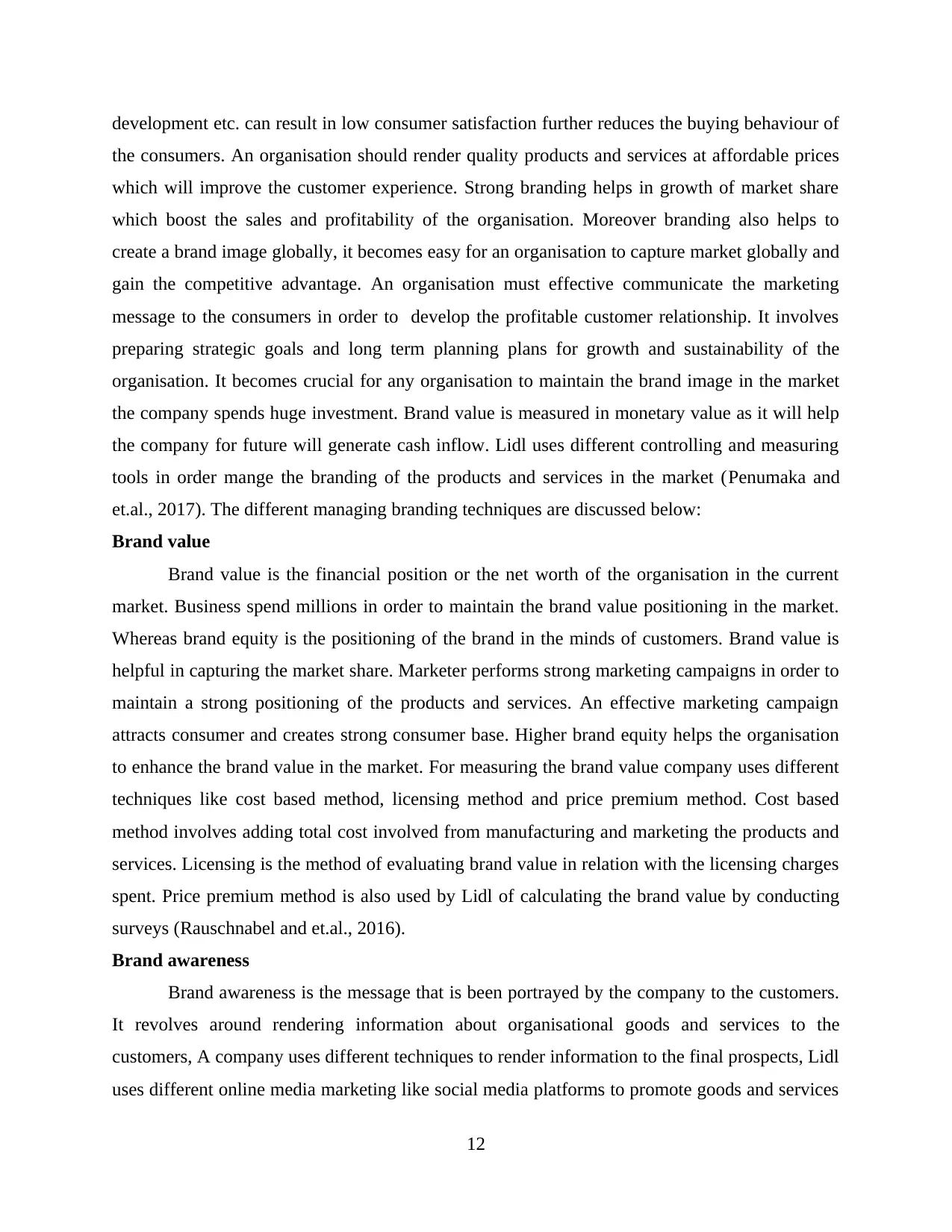
development etc. can result in low consumer satisfaction further reduces the buying behaviour of
the consumers. An organisation should render quality products and services at affordable prices
which will improve the customer experience. Strong branding helps in growth of market share
which boost the sales and profitability of the organisation. Moreover branding also helps to
create a brand image globally, it becomes easy for an organisation to capture market globally and
gain the competitive advantage. An organisation must effective communicate the marketing
message to the consumers in order to develop the profitable customer relationship. It involves
preparing strategic goals and long term planning plans for growth and sustainability of the
organisation. It becomes crucial for any organisation to maintain the brand image in the market
the company spends huge investment. Brand value is measured in monetary value as it will help
the company for future will generate cash inflow. Lidl uses different controlling and measuring
tools in order mange the branding of the products and services in the market (Penumaka and
et.al., 2017). The different managing branding techniques are discussed below:
Brand value
Brand value is the financial position or the net worth of the organisation in the current
market. Business spend millions in order to maintain the brand value positioning in the market.
Whereas brand equity is the positioning of the brand in the minds of customers. Brand value is
helpful in capturing the market share. Marketer performs strong marketing campaigns in order to
maintain a strong positioning of the products and services. An effective marketing campaign
attracts consumer and creates strong consumer base. Higher brand equity helps the organisation
to enhance the brand value in the market. For measuring the brand value company uses different
techniques like cost based method, licensing method and price premium method. Cost based
method involves adding total cost involved from manufacturing and marketing the products and
services. Licensing is the method of evaluating brand value in relation with the licensing charges
spent. Price premium method is also used by Lidl of calculating the brand value by conducting
surveys (Rauschnabel and et.al., 2016).
Brand awareness
Brand awareness is the message that is been portrayed by the company to the customers.
It revolves around rendering information about organisational goods and services to the
customers, A company uses different techniques to render information to the final prospects, Lidl
uses different online media marketing like social media platforms to promote goods and services
12
the consumers. An organisation should render quality products and services at affordable prices
which will improve the customer experience. Strong branding helps in growth of market share
which boost the sales and profitability of the organisation. Moreover branding also helps to
create a brand image globally, it becomes easy for an organisation to capture market globally and
gain the competitive advantage. An organisation must effective communicate the marketing
message to the consumers in order to develop the profitable customer relationship. It involves
preparing strategic goals and long term planning plans for growth and sustainability of the
organisation. It becomes crucial for any organisation to maintain the brand image in the market
the company spends huge investment. Brand value is measured in monetary value as it will help
the company for future will generate cash inflow. Lidl uses different controlling and measuring
tools in order mange the branding of the products and services in the market (Penumaka and
et.al., 2017). The different managing branding techniques are discussed below:
Brand value
Brand value is the financial position or the net worth of the organisation in the current
market. Business spend millions in order to maintain the brand value positioning in the market.
Whereas brand equity is the positioning of the brand in the minds of customers. Brand value is
helpful in capturing the market share. Marketer performs strong marketing campaigns in order to
maintain a strong positioning of the products and services. An effective marketing campaign
attracts consumer and creates strong consumer base. Higher brand equity helps the organisation
to enhance the brand value in the market. For measuring the brand value company uses different
techniques like cost based method, licensing method and price premium method. Cost based
method involves adding total cost involved from manufacturing and marketing the products and
services. Licensing is the method of evaluating brand value in relation with the licensing charges
spent. Price premium method is also used by Lidl of calculating the brand value by conducting
surveys (Rauschnabel and et.al., 2016).
Brand awareness
Brand awareness is the message that is been portrayed by the company to the customers.
It revolves around rendering information about organisational goods and services to the
customers, A company uses different techniques to render information to the final prospects, Lidl
uses different online media marketing like social media platforms to promote goods and services
12
⊘ This is a preview!⊘
Do you want full access?
Subscribe today to unlock all pages.

Trusted by 1+ million students worldwide
1 out of 16
Related Documents
Your All-in-One AI-Powered Toolkit for Academic Success.
+13062052269
info@desklib.com
Available 24*7 on WhatsApp / Email
![[object Object]](/_next/static/media/star-bottom.7253800d.svg)
Unlock your academic potential
Copyright © 2020–2025 A2Z Services. All Rights Reserved. Developed and managed by ZUCOL.





